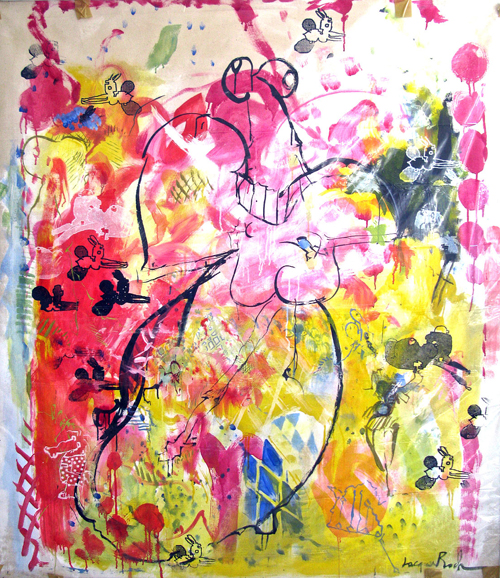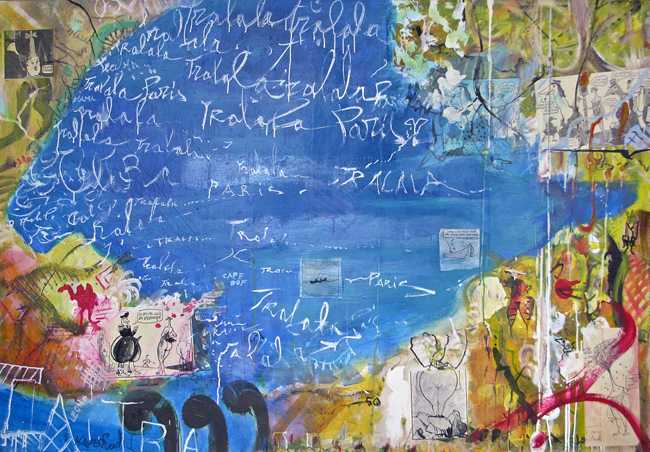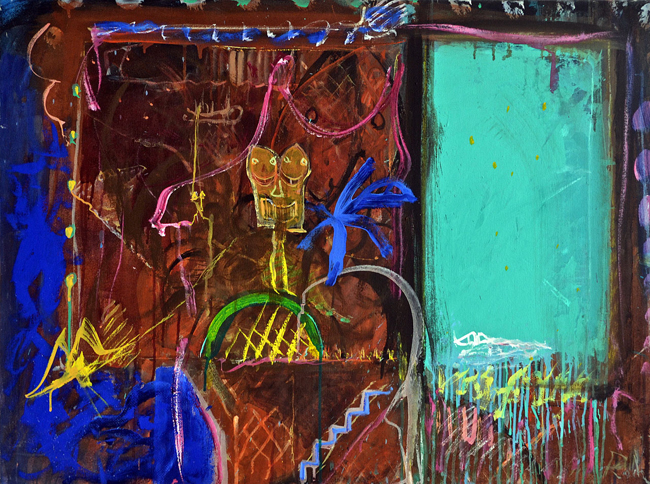Jacques Roch: “Ma Jolie”
Ron Morosan
February 2019
 Love Story, 1993. Acrylic and screen print on canvas, 65 x 56″,
Love Story, 1993. Acrylic and screen print on canvas, 65 x 56″,
image courtesy of Kim Foster Gallery
The Kim Foster Gallery is providing a rare opportunity to see a mini retrospective of the paintings of an outstanding French American artist who came of age in New York City in the 1980’s and developed a body of work that is unique and highly inventive in its conception and compositional approach.
Sadly, he died in 2015, but nevertheless, his presence is still strong in this work. We can also take note of the fact that over the years many young artists were paying close attention to Roch’s painting, because we see many echoes of his work in the East Village galleries.
Jacques Roch developed a way of making paintings that combined techniques that employ the palimpsest compositional approach of layering multiple images along with different methods of applying paint. While this compositional method was predominantly introduced by Rauschenberg, in Roch’s hand it becomes something totally different. Through his sense of humor and eccentric combinations of form, as well as a personal version of a wicked French humor, Roch created a distinctive style of his own.
In his painting Love Story from 1993 we see Roch’s approach in full development. The center of the painting is dominated by a curiously female form, not directly identifiable, but there are breasts, curves, and a clear linear body. This drawn form is placed over a multifaceted layering of silkscreened cartoon shapes, passages of expressionist paint and washes, and overlays of paint that conceal and reveal at the same time. What the message is is pure Roch. He developed a way of making painting as a form of personal dialogue with the viewer, a sort of self-conscious disguise where the message must be figured out. It is a playful approach that invites the viewer to study the painting; clearly, this is not one-glance work. Many levels of pictorial and spatial dialogue are taking place, so there is a puzzle to the work, and the presence of the artist as a performer. Some of the humor is self-conscious: Roch is making fun of himself, and, to some extent, his Frenchness.
Educated entirely in France, Roch’s art partakes of the soul of French tradition. We can identify in his drawings from the late 1960’s and early 1970’s a distinct influence of Art Nouveau. This extremely popular style is literally all over Paris and is most prominently evident in Hector Guimard’s designs for the Paris Metro.
 Ma Jolie, 1990. Acrylic and screen print on canvas, 54 x 78″, image courtesy of Kim Foster Gallery
Ma Jolie, 1990. Acrylic and screen print on canvas, 54 x 78″, image courtesy of Kim Foster Gallery
In much of his painting Roch could be called a social commentator. His large painting Ma Jolie of 1990, displayed as one enters the gallery, is like a large postcard with writing in French across most of the canvas. In taking in the whole of the canvas we see that it is in fact a seascape with a large expanse of blue implying an ocean. On closer examination there is a very funny and almost obscene cartoon at the lower left where a male figure, verging on being all balls with a pencil point member, is saying, “alors ma Jolie on debarque.” On the opposite side of the canvas is a cartoon of a female figure with the words ”Je me sans toute drole.” This is commentary on the sexual game of men and women that will always be controversial and contentious. In this painting Roch sends us a big postcard saying: it’s all “jouissance,” the plan of life as life.
The life of the artist was a big issue in Jacques’ art. Coming to New York as he was approaching middle age, he had to struggle with the English language and with making ends meet. However, he was able to turn his situation into a unique part of his art. There is a distinct existential dialogue going on, a self dialogue, or talking to himself, that takes place in his painting and this adds a presence to the work that puts it into the company of such artists as Paul Klee and Odilon Redon. The voice of the artist is clearly present in Jacques’ work and contributes to its power. In this way it is distinctly an artist’s art; it claims the territory of art as an artist’s language and doesn’t seek to serve an external objective world or a popular media world.
 The Door, 1987. Acrylic on canvas, 30 x 40″, image courtesy of Kim Foster Gallery
The Door, 1987. Acrylic on canvas, 30 x 40″, image courtesy of Kim Foster Gallery
One of the earliest paintings in the show is The Door from 1987. Here the existential psychic content of Roch’s work is evident. This is a deeply moving work in which to the left a figure like a human entity looks directly at the viewer. To the right is a rectangular blue form, the door. What door is it?
This mini-retrospective is a bit of a teaser. Certainly, Jacques Roch deserves a full retrospective in a museum, because he has achieved something special and unique that celebrates the individual artist as an eccentric who tells the truth.
Jacques Roch: “Ma Jolie”
Kim Foster Gallery
529 West 20th Street, New York City
January 7 -February 16, 2019
◊
Ron Morosan is an artist, writer, and curator. He has shown his work internationally at the American Pavilion of The Venice Biennale and the Circulo De Bellas Artes in Madrid, Spain. In the US he has shown at the New Museum and had a one-person exhibition at the New Jersey State Museum, and at numerous galleries in New York. He curated the Robert Dowd exhibiton, Subversive Pop, at Center Galleries in Detroit, as well as Denotation, Connotation, Implication at Eisner Gallery, City University of New York. He has written catalogues for many artists, including Enid Sanford, Tom Parish, Robert Dowd, and others. In the 1990’s he started and ran B4A Gallery in Soho, New York, writing press releases, articles, and catalogues.
